Stove Top – Slow Cooker – Instant Pot Pressure Cooker Instructions
My family and I look forward to enjoying corned beef and cabbage dinner as part of celebrating Saint Patrick’s Day every year. This is a great no-fuss meal to serve on Saint Patrick’s Day or any day that you desire.
We have also learned to fry up the leftovers for breakfast the next day to make the Corned Beef Bubble and Squeak. Also, here is a wonderful traditional Irish Soda Bread recipe to go with your Corned Beef and Cabbage meal. Irish soda bread can be found in homes and markets all over Ireland. In the United States, Irish Soda bread is popular when celebrating Saint Patrick’s Day.
You might also want to try this wonderful Guinness Beef Stew – Irish Beef Stew as it is also excellent served with Irish Soda Bread.
How To Purchase Corned Beef Brisket
Corned Beef Cooking Methods
Stove Top Cooking Instructions
Slow Cooker Cooking Instructions
Instant Pot Pressure Cooker Instructions
History of Corned Beef and Cabbage:
 You may be surprised, as I was, to learn that the traditional dish of Corned Beef and Cabbage, loved by so many on Saint Patrick’s Day, actually originated in New York City and not Ireland!
You may be surprised, as I was, to learn that the traditional dish of Corned Beef and Cabbage, loved by so many on Saint Patrick’s Day, actually originated in New York City and not Ireland!
We can thank the Irish American immigrants of New York City for the creation of Corned Beef and Cabbage. Starting at the end of the 1800’s, the Irish potato famine led to a huge influx of Irish immigrants settling in the United States, which continued steadily for the next 100 years. Back in Ireland, corned beef was around, but it was expensive and only affordable to the British land owners. Pork with potatoes was the regular diet staple of the common Irish man, and they especially loved Irish bacon which is a smoked and salted pork loin.
These new Irish American immigrants discovered pork was too expensive in the United States so they adapted to beef in their diet which was in abundance and less expensive to their pocket books. Also since the Irish working class lived so close to the Jewish population in New York City, they frequented Jewish delis and were delighted to discover that corned beef had a very similar taste to the Irish bacon they loved. Corned beef provided a tasty and affordable alternative to pork. Potatoes were easy to get in America, however many poor Irish families had to turn to cabbage since it was an even cheaper vegetable. They found the saltiness of the corned beef provided a nice flavor for the cabbage and it was a simple meal to prepare and feed the family and came close to reminding them of their favorite homeland meal.
Corned Beef and Cabbage became popular across the United States as a means to feed a family a cheap hearty meal. As Saint Patrick’s Day in America became an important day for Irish Americans to celebrate their Irish heritage, Corned Beef and Cabbage also became a tradition to enjoy on this holiday across the United States. So if you decide to visit Ireland during the Saint Patrick’s Holiday, you may find corned beef and cabbage on the menu at some restaurants, but the only people eating it will be the tourists.
1762 – The first Saint Patrick’s Day parade was held in New York City and not in Ireland!
1862 – Corned Beef and Cabbage was one of the menu items served at President Lincoln’s inauguration dinner.
1885 – Grover Cleveland, known for his love of food, was dismayed by the elaborate food offerings as he took his new Presidential office. The White House meals struck him as just too fancy since he inherited a French chef, put in place by his predecessor, Chester A. Arthur. One evening, as his dinner was served to him, he smelled the appetizing aroma of corned beef and cabbage drifting in from the servants quarters. He instructed his chef “Take this dinner down to the servants and bring their dinner to me.” He declared it the best meal he had in months!
Sources:
History Channel – Hungry History, Corned Beef and Cabbage: As Irish as Spaghetti and Meatballs, by Stephanie Butler, March 15, 2013.
United States Department of Agriculture: USDA Blog, How Corned Beef and Cabbage Became a Holiday Staple, by Craig Morris, March 15, 2013.
Riverfront Times, Gut Check, Fun Facts: President’s and Food – Grover Cleveland, by Ian Froeb, February 26, 2009.
About Corned Beef:
Corned Beef Brisket (also known as salt beef if you live in the UK) is a cut of meat (brisket) that has been cured (or pickled) in a seasoned brine. The brisket is a tough cut (meaning chewy). It is very flavorful and demands slow, low cooking. The brisket is a cut of beef from the breast or lower chest, right underneath the chuck at the front where there is a lot of connective tissue that supports the weight and movement of the animal. Long, slow cooking in moisture is necessary to tenderize the cut.
Corning is a form of curing that has nothing to do with corn. Corning was a method of preserving meat for storage before refrigeration was available. The Meat was dry-cured in coarse “corns” of salt. Pellets of salt, some the size of kernels of corn, were rubbed into the beef to keep it from spoiling and to preserve it. It would take 4-5 weeks to “corn” a beef with this method.
How To Purchase Corned Beef Brisket:
Today you can buy a brine cured corned beef at the store. A salt water brine has replaced the dry salt cure, but the name “corned beef” is still used, rather than “brined” or “pickled” beef. Spices that give corned beef its distinctive flavor are usually peppercorns and bay leaf, but spices may vary by regions.
A whole brisket is comprised of two sections – the point and flat (plank) cut. When cooked together, the fat from the point section bastes the leaner flat section. When buying a brisket you can choose between:
Point cut – The point cut is a rounder, thicker cut with more fat on it then the flat cut. Flat (or plank) cut – from the round is one of the five leanest cuts of beef, so if you’re looking for something a little lighter, this is the beef for you.
Look for a nice thick cut of corned beef with not too much fat on the outside, otherwise you will need to trim the fat down to 1/4-inch thickness. Corned beef shrinks abut 50%. For generous servings and leftovers, purchase abut 1 pound per person. Most grocery stores carry uncooked corned beef briskets that are pre-packaged and already brined – so all you have to do is braise it. Remember, leftovers can be used for tomorrow’s dinner, or you can freeze them for future use.
Remember: Leaner meats are not as tender as their fattier counterparts, so you will want to add a tenderizer like beer to “soften” the meat.
Whole Corned Beef Brisket – averages 12 to 14 pounds
First-Cut Corned Beef Brisket – averages 6 to 8 pounds
Half First-Cut Corned Beef Brisket – averages 3 to 4 pounds
Corned Beef Package and Storage Times:
USDA Food and Safety guidelines
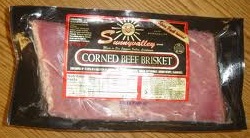 Uncooked corned beef in a pouch with pickling juices which has a “sell-by” date or no date may be stored 5 to 7 days in the refrigerator (40 F or less), unopened. Products with a “use-by” date can be stored unopened in the refrigerator until that date.
Uncooked corned beef in a pouch with pickling juices which has a “sell-by” date or no date may be stored 5 to 7 days in the refrigerator (40 F or less), unopened. Products with a “use-by” date can be stored unopened in the refrigerator until that date.
Drained and well wrapped, uncooked corned beef brisket, may be frozen for 1 month for best quality. It is recommended to drain the brine because salt encourages rancidity and texture changes. The flavor and texture will diminish with prolonged freezing, but the product is still safe. After cooking, corned beef may be refrigerated for about 3 to 4 days and frozen for about 2 to 3 months for best quality.
Preparation of Corned Beef:
Briskets are usually shrink-wrapped in brining solution so a good method of preparing your corned beef starts in your CLEAN kitchen sink. Place the shrink-wrapped corned beef in the clean sink and cut open the shrink wrap packaging. The flat cut brisket usually has very little juice in it; the point cut package will be juicier as it is filled with brine, Keep food safety in mind when preparing corned beef.
Corned Beef Cooking Methods:
When cooking your corned beef the Internal temperature of the cooked brisket should be at least 165 to 170 degrees F.
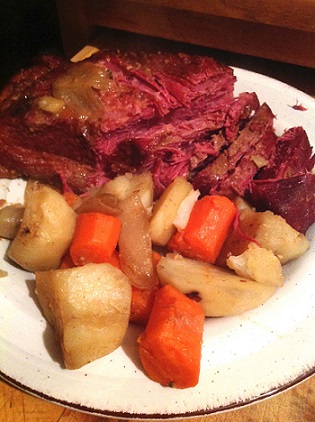 OVEN: Set the oven for 350 F or no lower than 325 degrees F. Place brisket fat-side up. Barely cover the meat with liquid about 1 inch. Keep the brisket covered throughout the cooking time. Allow about 1 hour per pound.
OVEN: Set the oven for 350 F or no lower than 325 degrees F. Place brisket fat-side up. Barely cover the meat with liquid about 1 inch. Keep the brisket covered throughout the cooking time. Allow about 1 hour per pound.
OVEN COOKING BAG: Preheat the oven to 325 degrees F. Add 1 tablespoon of flour to the bag plus 1/2 cup liquid. Follow the manufacturer’s instructions for closing the bag. For a 2 to 3-pound corned beef brisket, cook for 2 1/2 to 3 hours. For a 3 to 5-pound corned beef brisket, cook for 3 to 3 1/2 hours.
STOVE: Place brisket fat-side up in a large pot and cover it with liquid. Bring the liquid to a boil; reduce the heat and simmer, allowing about 1 hour per pound. Vegetables may be added during the last 45 minutes of cooking. Cook vegetables to desired tenderness.
SLOW COOKER: If using root vegetables, such as potatoes and carrots, put them in the bottom of slow cooker. Place brisket on top of vegetables (if using) or in bottom of cooker. Add about 1-1/2 cups of liquid or enough to cover meat. Cover and cook on high setting for the first hour of cooking. Then cook for 10 to 12 hours on the low setting or 5 to 6 hours on high. Cabbage wedges may be added on top of the brisket the last 20 minutes of cooking.
INSTANT POT or ELECTRIC PRESSURE COOKER: Place brisket fat-side up in pressure cooker pot with onions and spices, cover with liquid. Close the lid and seal the pressure valve. Manual cook for 45 minutes on high pressure, then natural release the pressure. Add the carrots and potatoes and manually cook for an additional 5-10 minutes on high pressure depending on desired tenderness of vegetables (5 mins firm/10 mins soft). Quick release the pressure when done. Open the lid and add the cabbage, close the lid and cook for 0 minutes on high pressure and quick release the pressure.
MICROWAVE: Calculate cooking time at 20 to 30 minutes per pound. Place brisket in a large casserole dish and add 1-1/2 cups of liquid. Cover with lid or vented plastic wrap and microwave on medium-low (30 percent power) for half the estimated time. Turn meat over and rotate dish. Microwave on high for remainder of time or until fork tender. Vegetables may be added during the final 30 minutes of cooking.
Sources:
FOCUS ON: Corned Beef, Why Eat Corned Beef on St. Patrick’s Day; by Food Safety and Inspection Service, United States Department of Agriculture, March 1995.
The Fastest Way to Cook a Beef Brisket; by Global Post, International News, 2014.
Meat of the Month: March; by Redfields Meats and Deli.
Corned Beef and Food Safety; by USDA, Food Safety and Inspection Service, August 2013.
Corned Beef…Brisket or Round? by Mary Ellen Burris, Wegmans, March 2013.
- 4 to 6 pounds whole corned beef brisket, uncooked (see how to purchase above)
- 3 tablespoon olive oil
- 3 large cloves garlic, peeled and chopped
- Seasoning (spice) packet
- 1 large onion, peeled and cut into 8 wedges
- 1 pint (16-ounce bottle) stout dark beer, divided
- 2 pounds baby Yukon Gold potatoes, skin on
- 1 pound carrots, peeled and cut into 2-inch length pieces
- 1 (2-pound) head of savory cabbage, cut through the core into 8 wedges
- 3 tablespoons mustard, prepared
- 2 tablespoons honey
- 1/2 teaspoon black pepper, freshly-ground
- 1 cup of beer
-
If your corned beef brisket comes in a package pre-brined, to reduce sodium, you may rinse the corned beef in water before cooking, if desired.
-
Place large heavy skillet, pot, or my preference a cast iron skillet or cast-iron Dutch oven on pre-heated medium-high stove burner. Add olive oil, chopped garlic, and seasoning packet from the corned beef package.
-
Place corn beef into pan, fat side up and lightly sear the meat for 4 minutes. Add onion wedges and then slowly pour 1/2 bottle of dark beer (about 1-inch) in the bottom of pan and bring just to a boil.

-
Reduce heat to low, cover pan, and let simmer for approximately 3 hours or until the meat is fork tender or about 165 to 170 degrees F. internally on your instant-read meat thermometer.
-
While the corned beef is simmering, clean potatoes and cut into 2-inch wedges. Try to keep each piece the same size for even cooking. Also clean or peel carrots and cut into 2-inch size rounds.
-
After the corned beef is cooked, add potatoes and carrots to the corned beef. Place vegetables around the meat and over the top, pour in the remaining 1/2 bottle of beer to keep 1 inch at bottom of pan, and replace cover. Cook for another 45 minutes then add the cabbage wedges by nestling into the pot and cover.

-
Prepare Beer Glaze (see below) and set aside.
-
Preheat broiler in your oven. Prepare a large baking pan by lining it with aluminum foil, set aside.
-
When the brisket is done cooking, remove vegetables around meat. Remove meat from pan and place in the foil lined baking pan, fat side up. about 1 cup of the beer from the pan and add to the previously prepared Beer Glaze mix; whisk together and set aside.
-
Return the potatoes and carrots to the stove top pan, add cabbage wedges and cover, let simmer on low.
-
Trim the fat from the top of the cooked corned beef, leaving 1/8-inch layer of fat. Spread 1/2 of the Beer Glaze over the top of the fat. Place the glazed corned beef under the broiler 6 inches from the heat for 3 to 4 minutes, until richly browned. Turn the corned beef over and spread the remaining Beer Glaze over the top of the meat, and broil for another 3 to 4 minutes.

-
Remove from the broiler. Allow the brisket to stand for about 20 minutes after removing from the heat (this will make it easier to slice). Carve the corned beef across the grain into thin slices.
-
Arrange the meat on a serving platter with the vegetables and potatoes. Serve with a selection of mustards and creamy horseradish sauce.
-
Serves many.
-
In a small bowl, mixing together the mustard, honey, and black pepper; set aside.
-
Finish the prepared Beer Glaze by adding an additional 1 cup of the beer liquid (from the corned beef pot) and whisk together.
Beer-Braised Corned Beef and Cabbage Slow Cooker and Instant Pot Pressure Cooker Recipe:
Slow Cooker (Crock Pot) Method:
Ingredients:
4 to 6 pounds whole raw corned beef brisket (see how to purchase above)
Seasoning (spice) packet*
1 head cabbage, outer leaves removed and cut into wedges along the spine.
6 to 8 medium red, white or Yukon Gold potatoes, skin on, halved or quartered
4 to 5 carrots, peeled and cut into 2 to 3-inch length pieces
1 medium onion, peeled and cut into large wedges
1 (12-ounce) bottle stout dark beer (Guiness preferred)
2 to 3 (32-ounce) containers of chicken stock or broth**
Salt and pepper to taste
* 1/2 teaspoon white and black peppercorns, 1 bay leaf, and 1/4 teaspoon cardamom can be substituted if the seasoning packet was not included with the cut of corned beef brisket.
** Water can be used instead of chicken stock. Learn how to make Chicken Stock – Basic Chicken Stock.
Preparation:
Preheat crock pot/slow cooker on high for 1 hour.
If your corned beef brisket comes in a package pre-brined, to reduce sodium, you may rinse the corned beef in water before cooking, if desired.
Place potatoes, carrots, and onions in one layer at the bottom of the preheated slow cooker. Place the brisket, fat side down, over the vegetables. Add additional vegetables along the side of the meat if desired. Open the seasoning packet, that came with the brisket, and sprinkle the spices over the meat. Pour the beer and then enough chicken stock over the corned beef brisket until completely covered.

Cook on high heat for 4 to 5 hours or on low heat for 8 hours or until the meat is fork tender or about 165 to 170 degrees F. internally on your instant-read meat thermometer.
When potatoes are tender, add cabbage and push down to immerse in the liquid. Cover with lid and continue to cook for 20 more minutes or until cabbage is tender. Remove cabbage and carrots with slotted spoon to let drain and place on a serving platter.
Remove the boiled potatoes to let drain. As a tasty option you can make these delicious Boiled Parsley Potatoes to serve with the Corned Beef and Cabbage (just adjust recipe ingredients for a smaller quantity of potatoes).
Adding cabbage to corned beef brisket
Remove corned beef brisket from slow cooker. Allow the brisket to stand for about 20 minutes after removing from the heat (this will make it easier to slice). Slice across the grain (perpendicular) into nice thick slabs and add to serving platter along with the cooked vegetables.
Any corned beef left over from a meal should be refrigerated promptly (within two hours of cooking or reheating). Use cooked-ahead or leftover corned beef within 3 to 4 days or freeze up to 2 months.
Serves many.
Instant Pot Pressure Cooker Instructions:
Ingredients: Use the same recipe ingredients as the Slow Cooker Instructions above. Note- Reduce vegetable quantity to: 4 medium to large yukon or red potatoes, 4 large carrots and 1/2 head of cabbage in order to fit in pressure cooker.
Preparation:
Add the brisket (4 to 6 pounds) fat side up into the inner pot, if a larger brisket, cut into large chunks to fit inside the pot. Nestle the onion wedges around the brisket. Open the spice packet that came with the brisket and sprinkle over the meat. Next pour the entire bottle of dark stout beer over the meat and pour in enough chicken stock to cover the meat.
Cover the pot with the lid and close to seal. Make sure the pressure valve is also closed to seal. Select the Manual button and set the cooking time for 45 minutes on high pressure. When the cooking time is done, natural release the pressure until the pin is dropped.
Open the lid and add in the carrots and potatoes. Close the lid to seal, and make sure the pressure valve is also closed to seal. Select the Manual button and set the cooking time to: (5 minutes for firm vegetables or 10 minutes for soft vegetables), on high pressure. When the cooking time is done, quick release the pressure valve until the pin is dropped.
As a final step, open the lid and add the cabbage wedges. Close the lid to seal, and make sure the pressure valve is also closed to seal. Select the Manual button and set the cooking time to 0 minutes, high pressure. When the cooking time is down, quick release the pressure valve until the pin is dropped. The cabbage should now be perfectly tender. Serve the corned beef, carrots, potatoes and cabbage on a platter.
 I get many readers asking what cooking/meat thermometer that I prefer and use in my cooking and baking. I, personally, use the Thermapen Thermometer. Originally designed for professional use, the Super-Fast Thermapen Thermometer is used by chefs all over the world. I only endorse a few products, on my web site, that I like and use regularly.
I get many readers asking what cooking/meat thermometer that I prefer and use in my cooking and baking. I, personally, use the Thermapen Thermometer. Originally designed for professional use, the Super-Fast Thermapen Thermometer is used by chefs all over the world. I only endorse a few products, on my web site, that I like and use regularly.
You can learn more or buy yours at: Super-Fast Thermapen Thermometer.
Sponsored Content
This is the type of pressure cooker that I prefer to use in my cooking: I get readers asking which electric pressure cooker brand I prefer to use for cooking. I personally use the Instant Pot Multi-Use Pressure Cooker. I love having 7 cooking functions in one space saving appliance – Pressure Cooker, Slow Cooker, Rice Cooker, Saute Pan, Steamer, Yogurt Maker and Warmer.
Learn more tips on How to Use an Instant Pot Pressure Cooker.
Additional St. Patrick’s Day Recipes:
 Irish Colcannon Potatoes – Mashed Potato with Kale and Bacon
Irish Colcannon Potatoes – Mashed Potato with Kale and BaconColcannon is true Irish soul food. The dish consists of mashing together buttery mashed potatoes with cooked kale or cabbage and leeks for flavoring.
Corned Beef Bubble and Squeak
Bubble and Squeak is a traditional Monday lunch in England to take the leftover potatoes and vegetables from Sunday supper and fry it up to enjoy for lunch the next day. The odd name is said to come from the noises made while cooking it.
Guinness Beef Stew – Irish Beef Stew
Most every pub you visit in Ireland will offer Beef and Guinness Stew on the menu. Stewing the beef in Guinness stout beer tenderizes the beef and adds a robust, malty flavor to the stew.
Dublin Coddle
A favorite Dublin dish of potatoes, onions, bacon rashers and pork sausages slow cooked together for the ultimate comfort meal.
Irish Lamb Stew
Traditionally Irish lamb stew is cooked with lamb meat (neck bones or shanks) and root vegetables such as potatoes and onions with water. The stew is cooked over low heat until the meat is fall apart tender.
Irish Soda Bread
Here’s a wonderful traditional Irish Soda bread recipe that can be found in homes and markets all over Ireland. In the United States, Irish Soda bread is popular to accompany Corned Beef and Cabbage when celebrating Saint Patrick’s Day.
Corned Beef and Cabbage
My family and I look forward to enjoying corned beef and cabbage dinner as part of celebrating Saint Patrick’s Day every year. This is a great no-fuss meal to serve on Saint Patrick’s Day or any day that you desire.
Irish Sausage Rolls
In Ireland, sausage rolls are very popular. You can find them served at pubs, at home parties, and can even be purchased ready made at bakeries.
Guinness Chocolate Cake
A moist rich chocolate cake with wonderful malty notes from the addition of Guinness stout beer.
Guinness Black Bottomed Cupcakes
Enjoy this twist on traditional black bottom cupcakes using Guinness Chocolate Cake and an Irish cream cheese filling
Categories:
Brisket Cabbage Recipes Dinner Irish Mid Atlantic Pressure Cooker Beef Recipes Pressure Cooker Stew Recipes Saint Patrick's Day Slow Cooker Beef Recipes Soups & Stews History Winter

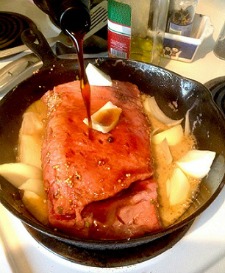
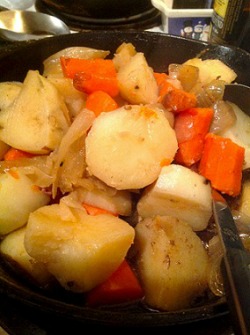
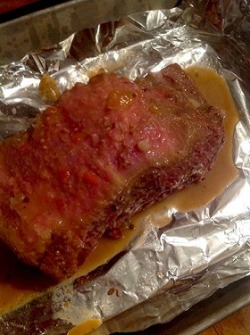

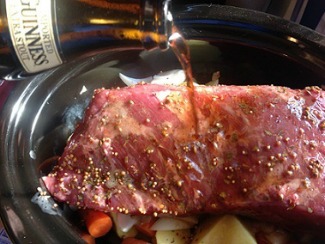
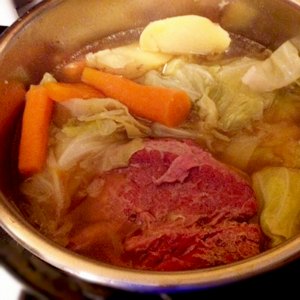

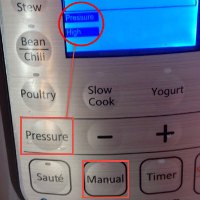

One Response to “Corned Beef and Cabbage History and Recipe”
Stephen Hlinka
I would say that when figuring out how many pounds per person of corned beef to buy would be 1-1/2 to 2 lbs per person, especially if you want a little left over, and even that can be a little questionable. I say this because in my opinion, a brisket will shrink by anywhere from a half to two thirds depending if you are cooking the whole, flat half, or point half. Then I take into consideration how well the brisket was trimmed, mostly on the point, but also on the outside. Depending on what company processed the corned beef makes a big difference too. I found that some take better care in trimming than others, and the all around integrity, quality and grade of beef varies from company to company as well, so buyer beware.
In any case, other than the St. Patrick’s day traditional meal, I always want to insure that I have lots of corned beef leftovers, and also want to make sure that I buy a few extra corned beefs to put in the freezer as they are usually on sale at that time of year.
One thing I never could get is that most people don’t know what to do with left over corned beef. I’ve changed peoples lives forever just making them homemade corned beef hash, instead of from the can. It’s like the difference between night and day. There’s so many other things to make from the leftovers like : Ruben sandwiches of course, but I can settle for just a corned beef and cabbage sandwich on white bread with a little mayo, or then again there are numerous other kinds of sandwiches I make. I also make pie, soup, stir fry, casserole, etc, the list goes on and on. One of my favorite simple recipes is just leftover corned beef, cabbage, and white rice. I just dice the corned beef, cut up the cabbage, stir fry it with day old rice in a little bit of butter, then add salt and pepper. The possibilities are endless in my kitchen what to do with left over corned beef. It’s all in the palate of the beholder.
To end my comment, I would like to thank the creator of this website, and everyone that’s involved with its content. I had stumbled on to this site this morning, this is my second comment, and I have to say I think I’ve found what I’ve been looking for. This website has everything about food and recipes that appeals to me and in all my interest. Thanks again.